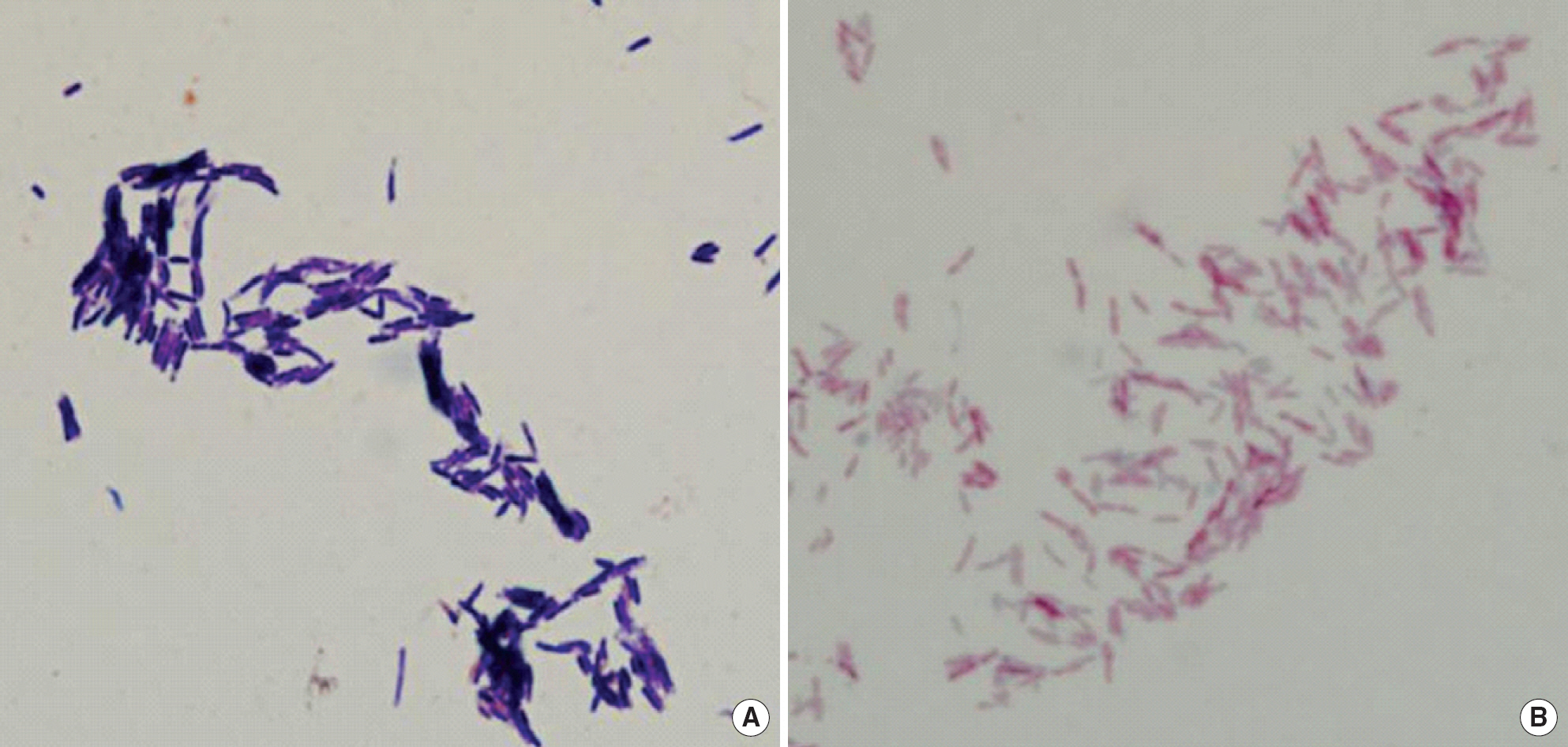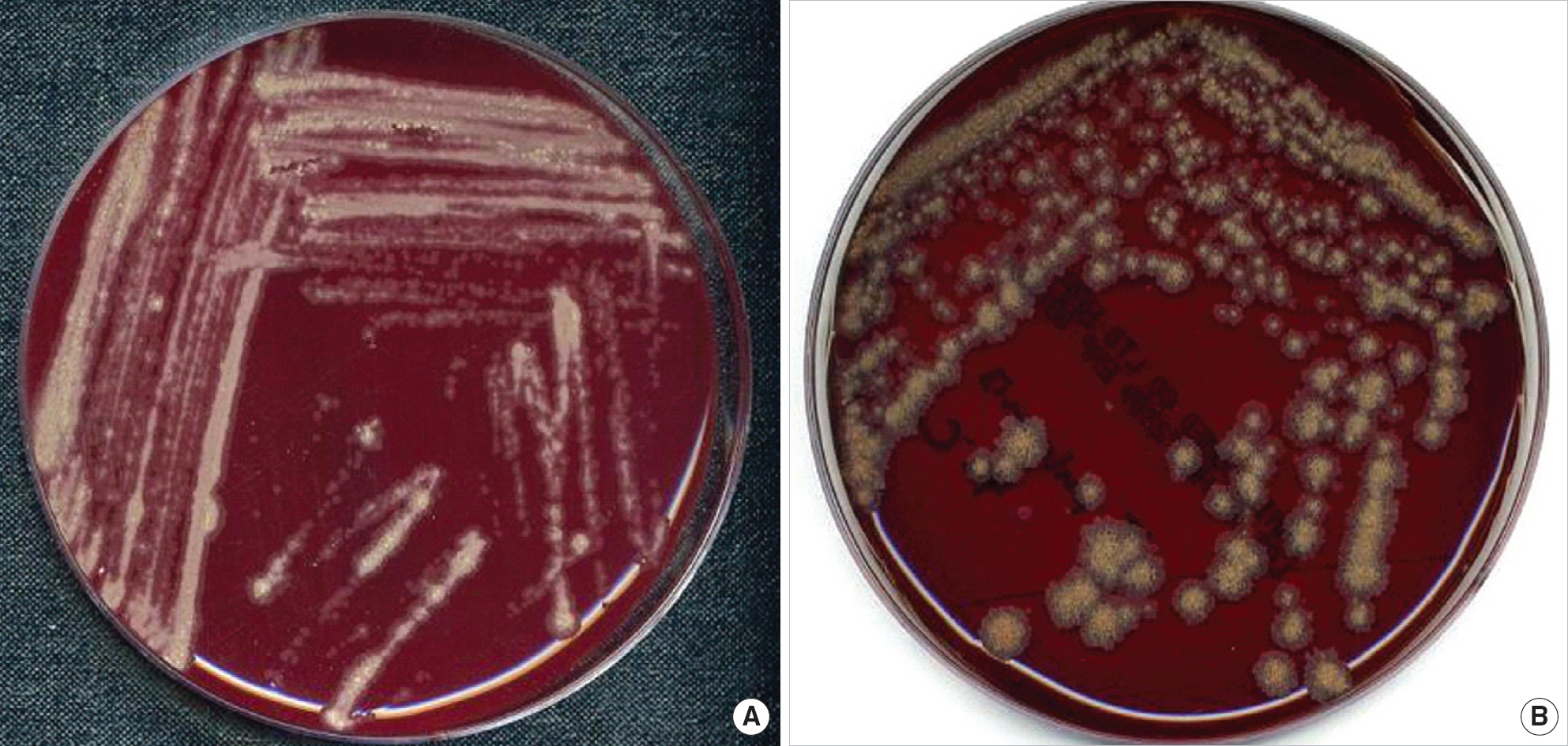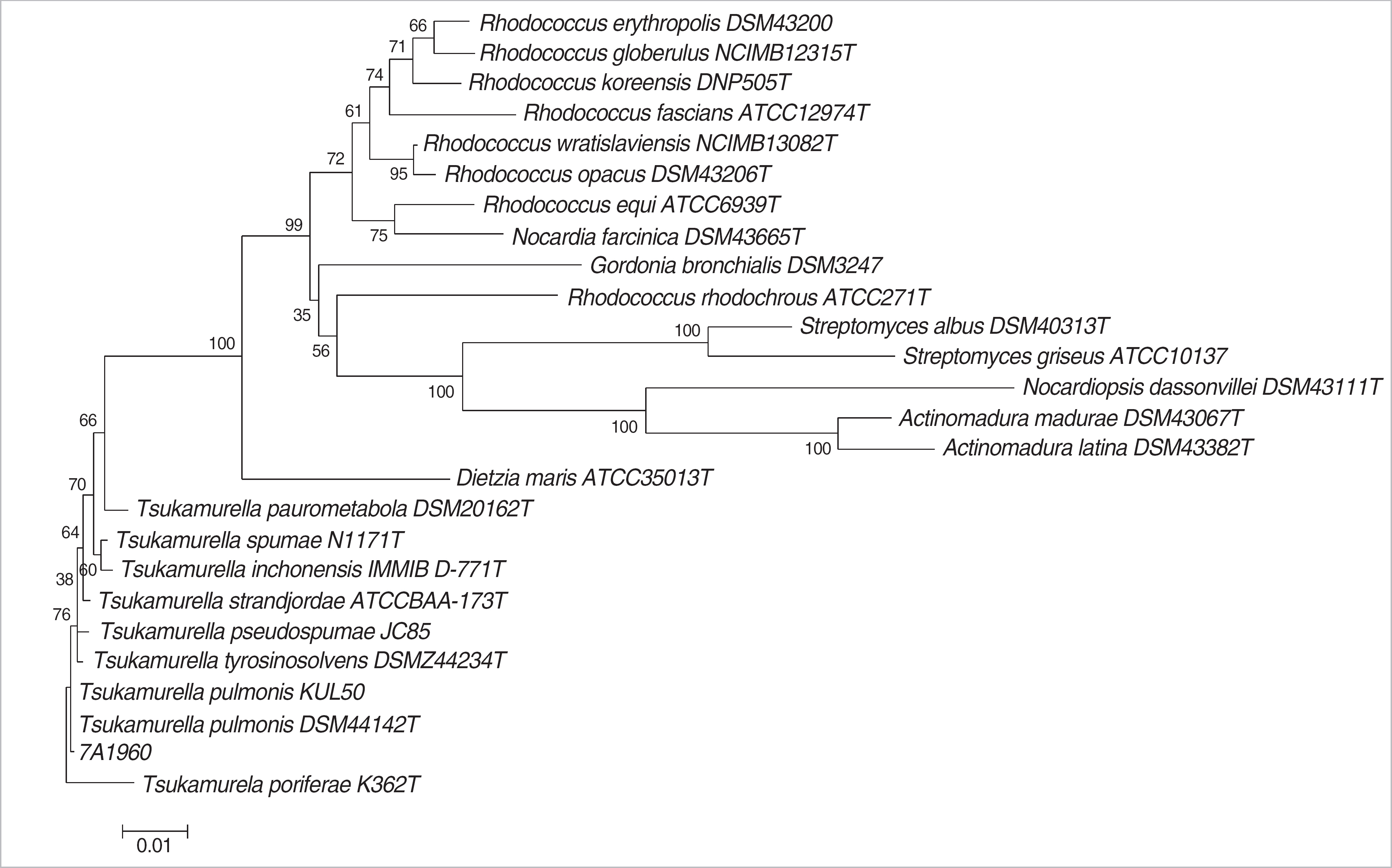Korean J Lab Med.
2009 Feb;29(1):41-47. 10.3343/kjlm.2009.29.1.41.
A Case of Catheter-Related Bacteremia of Tsukamurella pulmonis
- Affiliations
-
- 1Department of Laboratory Medicine, University of Ulsan College of Medicine and Asan Medical Center, Seoul, Korea. mnkim@amc.seoul.kr
- 2Department of Internal Medicine, University of Ulsan College of Medicine and Asan Medical Center, Seoul, Korea.
- KMID: 1781592
- DOI: http://doi.org/10.3343/kjlm.2009.29.1.41
Abstract
- Tsukamurella pulmonis is an aerobic actinomycete. We report a catheter-related bacteremia of T. pulmonis. A 39 yr-old male with ALL was hospitalized to receive bone marrow transplantation (BMT). Although the patient developed a high fever at the 7th hospital day (HD), it subsided with vancomycin treatment, and he received BMT at 9th HD. Fever resurged at 16th HD despite sustained treatment with vancomycin, meropenem, and amphotericin B, but subsided with removal of Hickman catheter (HC) at 19th HD. Three sets of blood cultures comprising one from the HC and two from venipunctures were taken at 7th, 16th, and 19th HD, and the distal tip of the HC was also cultured. The aerobic vials of all 3 HC-withdrawn blood cultures and one peripheral blood culture taken at 19HD and the HC tip culture grew long, straight, thin gram-positive rods that were positive on modified Kinyoun stain. This organism showed tiny, rough, grey colonies after 3-day incubation and grew to large flat colonies when incubation was extended. It was catalase-positive, urease-positive, and alkaline-slant/alkaline-deep on triple sugar iron agar, and hydrolyzed hypoxanthine. The sequence of 1,296 base pairs of 16S rRNA of this organism showed a 100.0% homology with the published sequence of T. pulmonis DSM 44142T. To our knowledge, this is the first report of T. pulmonis bacteremia in Korea.
Keyword
MeSH Terms
-
Actinomycetales/classification/genetics/isolation & purification
Actinomycetales Infections/diagnosis/*microbiology/therapy
Adult
Bacteremia/*diagnosis/microbiology/therapy
Bone Marrow Transplantation
Catheter-Related Infections/*microbiology
Humans
Leukemia, Myeloid, Acute/therapy
Male
Phylogeny
RNA, Ribosomal, 16S/genetics
Figure
Cited by 1 articles
-
A Case Report of
Tsukamurella pulmonis Infection Misidentified as Atypical Mycobacteria
Ah Ra Cho, Hye Ryoun Kim, Mi-Kyung Lee, Seong Ho Choi, Sin Weon Yun
Korean J Clin Microbiol. 2010;13(2):93-97. doi: 10.5145/KJCM.2010.13.2.93.
Reference
-
1.Conville PS., Witebsky FG. Nocardia, Rhodococcus, Gordonia, Actinomadura, Streptomyces, and Other Aerobic Actionmycetes. In:. Murray PR, Baron EJ, editors. Manual of clinical microbiology. 9th ed.Washington DC: ASM Press;2007. p. 519–26.2.Tsukamura M., Kawakami K. Lung infection caused by Gordona aurantiaca (Rhodococcus aurantiacus). J Clin Microbiol. 1982. 16:604–7.3.Tsukamura M., Hikosaka K., Nishimura K., Hara S. Severe progressive subcutaneous abscesses and necrotizing tenosynovitis caused by Rhodococcus aurantiacus. J Clin Microbiol. 1988. 26:201–5.4.Prinz G., Ban E., Fekete S., Szabo Z. Meningitis caused by Gordona aurantiaca (Rhodococcus aurantiacus). J Clin Microbiol. 1985. 22:472–4.5.Lai KK. A cancer patient with central venous catheter-related sepsis caused by Tsukamurella paurometabolum (Gordona aurantiaca). Clin Infect Dis. 1993. 17:285–7.6.Shapiro CL., Haft RF., Gantz NM., Doern GV., Christenson JC., O'Brien R, et al. Tsukamurella paurometabolum: a novel pathogen causing catheter-related bacteremia in patients with cancer. Clin Infect Dis. 1992. 14:200–3.7.Chong Y., Lee K., Chon CY., Kim MJ., Kwon OH., Lee HJ. Tsukamurella inchonensis bacteremia in a patient who ingested Hydrochloric acid. Clin Infect Dis. 1997. 24:1267–8.8.Relman DA. Universal bacterial 16S rRNA amplification and sequencing. Persing DH, Smith TF, editors. Diagnostic molecular microbiology principles and applications. 1st ed.Washington DC: ASM Press;1993. p. 489–95.9.National Committee for Clinical Laboratory Standards. Interpretive criteria for identification of bacteria and fungi by DNA target sequencing; approved guideline. NCCLS document MM18-A. Wayne, PA: Clinical and Laboratory Standards Institute;2008.10.National Committee for Clinical Laboratory Standards. Susceptibility testing of Mycobacteria, Nocardiae, and other aerobic Actinomycetes; approved standard. NCCLS document M24-A. Wayne, PA: Clinical and Laboratory Standards Institute;2003.11.National Committee for Clinical Laboratory Standards. Principles and procedures for blood cultures; approved guideline. NCCLS document M47-A. Wayne, PA: Clinical and Laboratory Standards Institute;2007.12.Auerbach SB., McNeil MM., Brown JM., Lasker BA., Jarvis WR. Outbreak of pseudoinfection with Tsukamurella paurometabolum traced to laboratory contamination: efficacy of joint epidemiological and laboratory investigation. Clin Infect Dis. 1992. 14:1015–22.13.Schwartz MA., Tabet SR., Collier AC., Wallis CK., Carlson LC., Nguyen TT, et al. Central venous catheter-related bacteremia due to Tsukamurella species in the immunocompromised host: a case series and review of the literature. Clin Infect Dis. 2002. 35:e72–7.14.McNeil MM., Brown JM. The medically important aerobic Actinomycetes: epidemiology and microbiology. Clin Microbiol Rev. 1994. 7:357–417.15.Kattar MM., Cookson BT., Carlson LD., Stiglich SK., Schwartz MA., Nguyen TT, et al. Tsukamurella strandjordae sp. nov., a proposed new species causing sepsis. J Clin Microbiol. 2001. 39:1467–76.16.Yassin AF., Rainey FA., Brzezinka H., Burghardt J., Rifai M., Seifert P, et al. Tsukamurella pulmonis sp. nov. Int J Syst Bacteriol. 1996. 46:429–36.17.Bizet C., Barreau C., Harmant C., Nowakowski M., Pietfroid A. Identification of Rhodococcus, Gordona and Dietzia species using carbon source utilization tests (“Biotype-100” strips). Res Microbiol. 1997. 148:799–809.
- Full Text Links
- Actions
-
Cited
- CITED
-
- Close
- Share
- Similar articles
-
- A Case Report of Tsukamurella pulmonis Infection Misidentified as Atypical Mycobacteria
- A Case of Catheter-Related Bloodstream Infection by Tsukamurella inchonensis in a Pediatric Patient Receiving Home Intravenous Antibiotic Treatment
- A Case of Catheter-Related Bloodstream Infection Caused by Tsukamurella tyrosinosolvens
- A case of Tsukamurella tyrosinosolvens peritonitis associated with continuous ambulatory peritoneal dialysis
- Treatment of Catheter-related Bacteremia with an Antibiotic Lock Protocol in Hemodilaysis Patients




